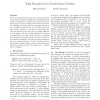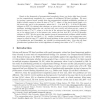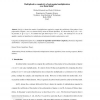13 search results - page 1 / 3 » Tight Bounds on the Complexity of Recognizing Odd-Ranked Ele... |
CORR
2006
Springer
13 years 4 months ago
2006
Springer
Let S = s1, s2, s3, ..., sn be a given vector of n distinct real numbers. The rank of z R with respect to S is defined as the number of elements si S such that si z. We consider...
SODA
2004
ACM
13 years 6 months ago
2004
ACM
We close the gaps between known lower and upper bounds for the online partial-sums problem in the RAM and group models of computation. If elements are chosen from an abstract grou...
COCO
2004
Springer
13 years 8 months ago
2004
Springer
Based on the framework of parameterized complexity theory, we derive tight lower bounds on the computational complexity for a number of well-known NP-hard problems. We start by pr...
CSR
2006
Springer
13 years 8 months ago
2006
Springer
Let Mq (n ) denote the number of multiplications required to compute the coefficients of the product of two polynomials of degree n over a q -element field by means of bilinear alg...
WDAG
2007
Springer
13 years 11 months ago
2007
Springer
The timestamp problem captures a fundamental aspect of asynchronous distributed computing. It allows processes to label events throughout the system with timestamps that provide in...



